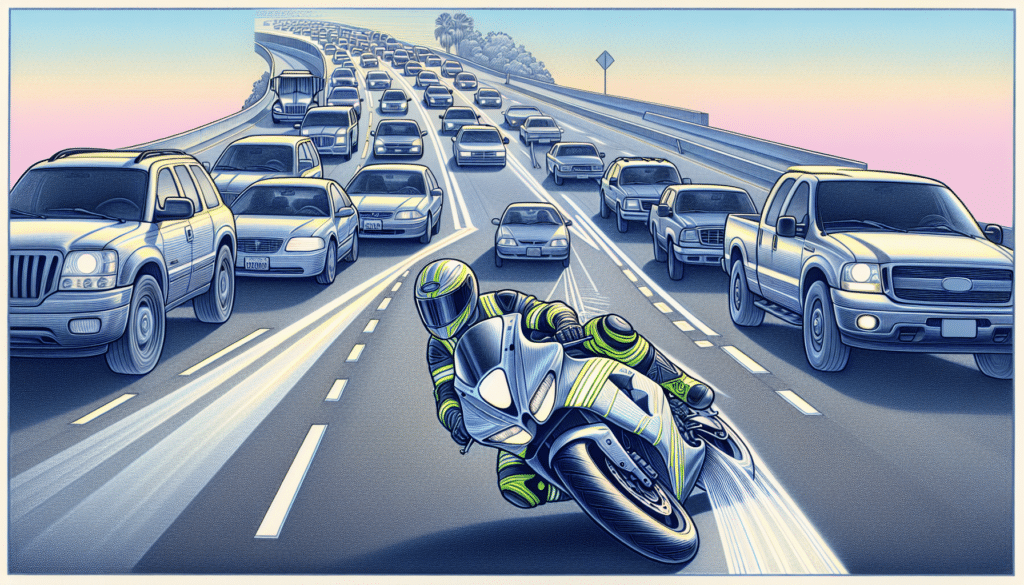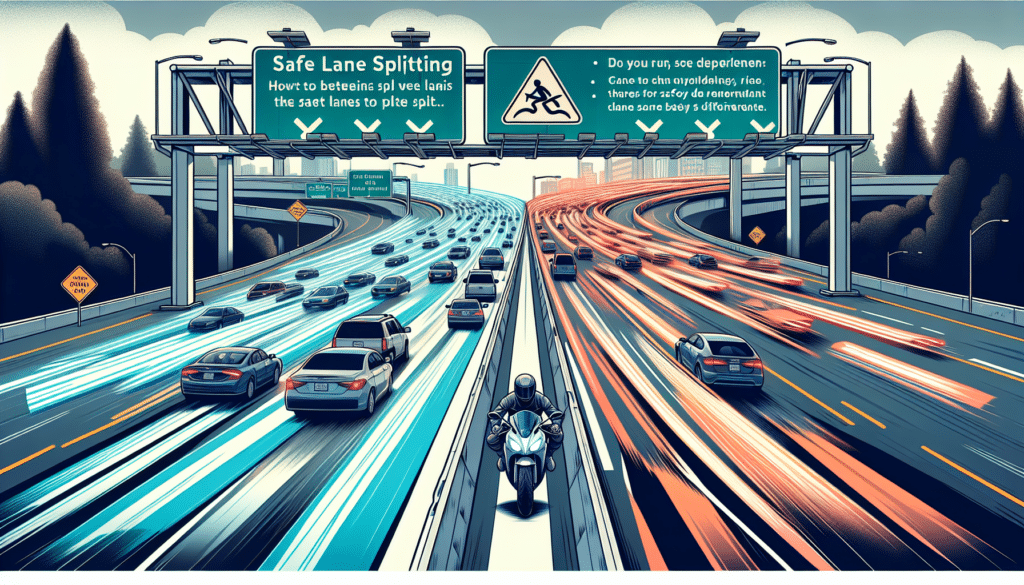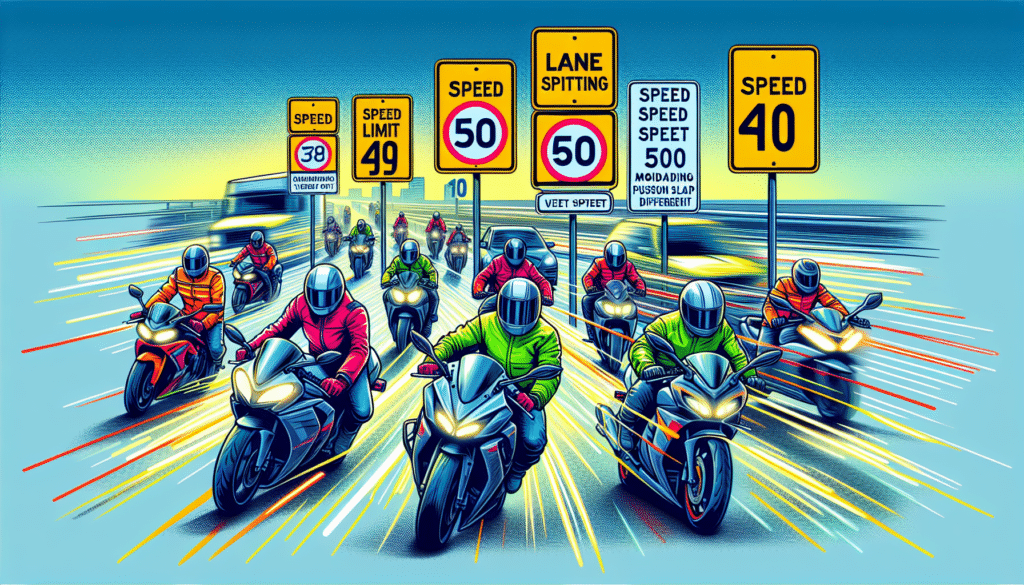Is lane splitting legal in California, and can you still get a lane splitting ticket California?
Yes, lane splitting is legal, but motorcyclists can receive tickets for unsafe lane splitting.
This article explains the rules, why you might get a lane splitting ticket California, and how to contest it.
Key Takeaways
Lane splitting is legal in California and is defined as a motorcyclist riding between lanes of traffic, but it must be done safely to avoid tickets for reckless behavior or non-adherence to road rules.
The California Highway Patrol provides guidelines for safe lane splitting, including maintaining specific speed differentials and choosing appropriate lanes, to minimize the risk of accidents.
Motorcyclists who receive lane splitting tickets can contest them by collecting evidence and possibly hiring a lawyer, especially if the ticket was issued unfairly or due to misunderstandings of the legal guidelines.
Understanding Lane Splitting in California

Lane splitting, often a topic of heated debate, involves motorcyclists riding between lanes of traffic, a practice also known as lane sharing. According to California Vehicle Code Section 21658.1, it is defined as driving a motorcycle between rows of stopped or moving vehicles in the same lane, including when they lane split. This practice is distinct from lane filtering, which involves navigating between stopped or slow-moving cars, typically at intersections.
California stands out as the only state in the U.S. where lane splitting is legal, a status it achieved on August 19, 2016, under the California lane splitting law. This legal recognition acknowledges the long-standing practice of lane splitting on California’s freeways, aimed at reducing congestion and saving time for both motorcyclists and car drivers.
Motorcyclists are permitted to split lanes, also known as using a motorcycle lane, only when it is safe. They must carefully assess the surrounding conditions before proceeding. This means considering factors such as speed, traffic conditions, and the behavior of other drivers. It is important to note that riding on the shoulder is illegal and does not count as lane splitting.
Understanding these nuances is key to navigating the roads safely and legally. We will now discuss scenarios where you might receive a ticket even though lane splitting is legal in California.
Can You Get a Ticket for Lane Splitting?
Despite lane splitting being legal in California, motorcyclists are not given free rein to navigate through traffic recklessly. With lane splitting legal, they could still get ticketed for irresponsible lane splitting or non-adherence to speed limits and other road rules. The essence of the law is safety; reckless driving while lane splitting can attract a ticket under California Motor Vehicle Code § 23103.
Unsafe lane splitting, characterized by excessive speed or erratic maneuvering, can lead to citations. For instance, if a motorcyclist is weaving aggressively through traffic or splitting lanes at high speeds, they are likely to face legal repercussions. This underscores the importance of maintaining a reasonable speed differential and being mindful of road conditions.
Regardless of the legality of lane splitting, motorcyclists are still required to abide by California’s motor vehicle laws. This means observing speed limits, signaling appropriately, and respecting other vehicles on the road. Abiding by these rules not only ensures safety but also helps avoid unnecessary tickets.
California Highway Patrol Guidelines on Lane Splitting

The California Highway Patrol (CHP) is instrumental in maintaining the safety of motorcyclists who split lanes. It has devised an extensive set of guidelines to aid motorcyclists in lane splitting responsibly and safely. These guidelines serve as a crucial resource for both new and experienced riders.
One of the key recommendations from the CHP includes adhering to specific speed differentials when moving in the same direction. For instance, when traffic is moving at 30 mph or less, motorcyclists should not exceed 10 mph more than the flow of traffic. This helps minimize sudden movements and the risk of collisions. Additionally, the CHP advises lane splitting to be performed in lanes 1 and 2 (the far-left lanes) where traffic is usually more predictable.
The CHP guidelines also emphasize the importance of considering overall speeds, road conditions, and traffic flow. Motorcyclists are encouraged to assess the total environment before deciding to split lanes. This comprehensive approach to safety makes sure that lane splitting occurs in a way that minimizes risk for motorcyclists and fellow road users alike.
Legal Aspects of Lane Splitting Tickets
Receiving a lane splitting ticket can be a frustrating experience, especially when you believe you were riding safely. Under the California Vehicle Code Section 21658.1, lane splitting is defined and regulated, and violating these regulations can result in fines and penalties. Understanding the legal aspects of these tickets is crucial for any motorcyclist.
Violations for lane splitting can carry varying penalties depending on the specifics of the incident. The speed of the motorcyclist, the method of lane splitting, and the prevailing traffic conditions are factors considered when levying fines. It’s important to note that these penalties are not just financial; they can also impact your driving record and insurance premiums.
To navigate the legal complexities of lane splitting tickets on undivided streets, one needs a thorough understanding of the law and its implications. Being aware of potential consequences can assist in making informed decisions on the road, thus preventing avoidable violations.
How to Contest a Lane Splitting Ticket
To contest a lane splitting ticket, one needs to adopt a strategic approach that begins with the collection of all pertinent evidence. This can include dashcam footage, witness statements, and any other documentation that supports your case. Keeping a detailed record of all communications and documents related to your ticket is also essential.
Motorcyclists can use self-help services like Ticket Snipers to contest lane splitting tickets. These services offer assistance in preparing and submitting necessary documents to challenge the ticket. Ticket Snipers, for example, provides support for various traffic infractions, including lane splitting, speeding, and red light violations.
If you believe the ticket was issued unfairly, hiring an attorney might be the best course of action. An experienced lawyer can help identify discrepancies in the ticketing officer’s observations and present evidence that demonstrates you were riding safely and within legal guidelines.
Attending the court hearing and clearly articulating your side of the story can also significantly impact the outcome.
Engaging a Lawyer for Lane Splitting Violations
Hiring a lawyer for lane splitting violations can greatly enhance your chances of a successful defense. Legal representation is particularly beneficial in complex cases where proving fault and fighting allegations of negligence are crucial. A skilled attorney can gather evidence, determine liability, and negotiate fair compensation for any injuries or damages sustained.
Motorcycle accident lawyers often work on a contingency fee basis, meaning they only get paid if they win your case. This can be a significant advantage, as it ensures your lawyer is motivated to achieve the best possible outcome for you. Additionally, contacting a California law firm for consultation and legal advice can provide you with a clear understanding of your options and the best course of action.
Engaging a lawyer can help navigate the complexities of traffic laws and ensure that your rights are protected. Some reasons to consider hiring a lawyer for traffic-related issues include:
Defending against wrongful blame
Proving fault in an accident
Seeking compensation for injuries or damages
Dealing with insurance companies
Understanding and challenging traffic violations
Having professional legal assistance can make a substantial difference in the outcome of your case.
Safety Tips for Lane Splitting Motorcyclists

For motorcyclists who split lanes, safety should always be paramount. Following the CHP guidelines is essential to ensure safe and responsible riding. This includes:
Being visible by wearing bright or reflective clothing
Avoiding blind spots of other vehicles
Practicing reasonable, respectful, and road-aware behavior
Some critical safety tips for motorcyclists include:
Avoid lingering in the blind spots of other vehicles
Split lanes only when traffic is moving at 30 mph or less and your speed is no more than 10 mph faster than the flow of traffic
Consider the total environment, including lane width, the size of surrounding vehicles, and current roadway, weather, and lighting conditions.
Lane splitting is typically safer between the far-left lanes compared to other lanes of traffic. It’s important to avoid driving too closely to large vehicles like big rigs, buses, and motorhomes due to the significant dangers they can pose. Keeping a safe distance can help ensure your safety on the road. By adhering to these safety tips, motorcyclists can reduce risks and enjoy a safer riding experience.
Responsibilities of Car Drivers During Lane Splitting
Car drivers have a significant role in ensuring the safety of motorcyclists who split lanes. It is important to remember the following:
It is illegal to intentionally block or impede a motorcyclist while they are lane splitting.
Drivers who engage in such behavior can face legal consequences.
Opening a vehicle door to obstruct a motorcyclist is prohibited and can result in penalties.
The California Highway Patrol, a motorcycle organization focused on safety, has issued tips for vehicle drivers to help prevent motorcycle accidents. It is important for drivers to focus their attention on the road and be aware of motorcycles that may be splitting lanes. This practice can help prevent accidents and ensure the safety of everyone on the road. When driving in the far-left lane, it is important for drivers to move to the left within their lane in order to provide enough space for motorcyclists to pass safely. This helps ensure a smoother flow of traffic and reduces the risk of accidents. Awareness and cooperation from car drivers are essential for the safety of all road users.
With understanding and respect for the practice of lane splitting on divided and undivided streets, car drivers can help foster a safer road environment, contributing to traffic safety. This mutual respect between motorcyclists and drivers is key to reducing accidents and ensuring smoother traffic flow.
Impact of Lane Splitting on Personal Injury Cases
Establishing fault and negligence is crucial in personal injury cases involving lane splitting. If a motorcyclist is harmed by a driver attempting to block them from lane splitting, they may have grounds for a personal injury claim. Demonstrating that the driver acted negligently is essential to establishing liability.
Legal representation is vital in handling motorcycle accident claims involving lane splitting. An experienced attorney can navigate traffic laws, evaluate evidence, and handle communication with insurance companies. This can significantly impact the outcome of the case, ensuring that the injured party receives fair compensation for medical bills, ongoing care, damage to the motorcycle, and lost wages.
Excessive speed or erratic maneuvering, indicative of unsafe lane splitting, can place partial or complete liability on the motorcyclist in an accident. Consulting a motorcycle accident attorney can help navigate through bias and blame from insurance companies, providing a fair chance for the injured motorcyclist.
Summary
Navigating the complexities of lane splitting in California requires a thorough understanding of the legal landscape, safety guidelines, and the responsibilities of all road users. Lane splitting, while legal, must be performed safely to avoid tickets and ensure the well-being of motorcyclists and other drivers.
By following the California Highway Patrol’s guidelines, contesting unjust tickets, and seeking legal representation when necessary, motorcyclists can protect their rights and ride confidently. The mutual respect between motorcyclists and drivers plays a crucial role in maintaining road safety, ultimately contributing to a smoother and more efficient traffic flow. Ride safe and stay informed.
Frequently Asked Questions
Is lane splitting legal in California?
Yes, lane splitting is legal in California as long as it is done safely, according to the California Vehicle Code Section 21658.1.
What are the California Highway Patrol guidelines for lane splitting?
The California Highway Patrol recommends a speed differential of no more than 10 mph when traffic is moving at 30 mph or less and advises lane splitting in the far-left lanes. It’s important to follow these guidelines for safe lane splitting.
What should car drivers do during lane splitting?
Car drivers should not block or impede motorcyclists and should remain aware of motorcycles on the road, providing ample room for them to pass, especially in the far-left lanes. Drive safely.




